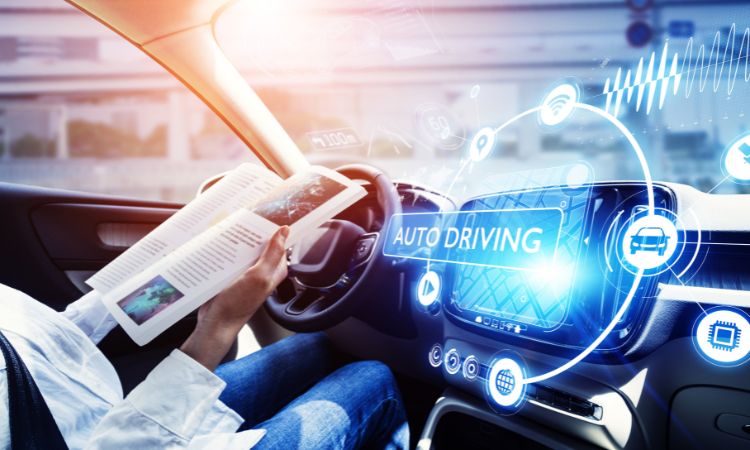The global automotive digital cockpit market size is poised for substantial growth in the coming years, with a projected Compound Annual Growth Rate (CAGR) of 11.8% during the period 2024-2032. This remarkable surge is expected to be driven by a convergence of factors, including the demand for a superior driving experience, AI-powered high-performance computing, enhanced system-on-chip (SoC) architecture with visualization, scalability with a unified software framework, enhanced safety, smarter navigation, rich visual experiences, and superior audio. The key markets for this evolution are anticipated to be North America, Europe, and Asia.
In this blog post, we will delve into the fascinating world of automotive digital cockpits, with a particular focus on the pivotal role that Augmented Reality (AR) plays in revolutionizing the driving experience. We will explore the basics of AR, how it enhances digital cockpits, the technical aspects of its integration, user experience considerations, and what the future holds for this transformative technology. So, fasten your seatbelts, and let’s embark on a journey through the intersection of automobiles and augmented reality.
Augmented Reality Basics
Before we dive into the realm of automotive digital cockpits, let’s start with the basics of Augmented Reality. Augmented Reality is a technology that superimposes digital information or virtual objects onto the real-world environment, thereby enhancing our perception of reality. Unlike Virtual Reality (VR), which immerses users in a completely digital world, AR enhances the real world by adding digital elements to it.
AR has found applications in various industries, from gaming and education to healthcare and manufacturing. In the context of automotive digital cockpits, AR introduces a new dimension of interaction and information presentation that can greatly benefit drivers and passengers alike.
Current State of Automotive Digital Cockpits
As we stand on the precipice of a new era in automotive technology, it’s essential to understand the current state of digital cockpits. Traditionally, digital cockpits have featured infotainment systems, navigation displays, and instrument clusters. These systems have come a long way in terms of functionality and user-friendliness, but they still face challenges and limitations.
Drivers today expect more than just the basics from their in-car systems. They demand seamless connectivity, intuitive interfaces, and personalized experiences. This is where Augmented Reality steps in to bridge the gap.
The Integration of Augmented Reality
Benefits of Augmented Reality in Automotive Cockpits
- Improved Navigation and Wayfinding: Augmented Reality can provide real-time, location-based information to drivers, such as navigation cues overlaid onto the windshield. This not only simplifies navigation but also enhances safety by reducing the need for drivers to take their eyes off the road.
- Enhanced Safety and Driver Assistance: AR can assist drivers by highlighting potential hazards, providing lane-keeping guidance, and even identifying pedestrians or cyclists in blind spots. These features significantly contribute to road safety.
- Interactive Information Displays: With AR, information can be presented in a more interactive and engaging manner. For example, AR can overlay details about nearby landmarks, restaurants, and points of interest on the windshield, enhancing the overall driving experience.
Real-life Examples of AR in Modern Vehicles
In recent years, automotive manufacturers and technology companies have been incorporating AR into their vehicles in innovative ways:
- Head-up Displays (HUDs): HUDs project critical information onto the windshield, allowing drivers to access data like speed, navigation directions, and even incoming calls without taking their eyes off the road.
- Augmented Reality Windshields: Some luxury car brands have introduced windshields with AR capabilities that display key information and even highlight potential hazards directly on the glass.
- In-car Projection Systems: AR can be integrated into infotainment systems, projecting information onto the dashboard or other surfaces within the vehicle’s interior.
These real-world examples demonstrate how AR is already making an impact in modern vehicles by providing drivers with enhanced information and assistance.
Technical Aspects of AR in Digital Cockpits
To make Augmented Reality work seamlessly within automotive digital cockpits, several technical considerations come into play:
Hardware Requirements
AR systems in vehicles require specialized hardware, including high-resolution cameras, sensors, and projectors. These components work together to capture the real-world environment and overlay digital information.
Software Development and Integration
Developing software that can interpret sensor data, create augmented content, and display it in a user-friendly manner is a significant challenge. Integration with existing vehicle systems and interfaces must also be carefully managed.
Challenges and Solutions in Implementing AR Technology
Implementing AR in digital cockpits comes with its share of challenges, such as ensuring data accuracy, minimizing distraction, and addressing potential cybersecurity concerns. However, automotive manufacturers and technology providers are actively addressing these issues by developing advanced algorithms, intuitive user interfaces, and enhanced safety features.
User Experience and Safety Considerations
One of the primary concerns in integrating AR into digital cockpits is ensuring a positive user experience while maintaining safety. Here are some key considerations:
User-Friendly Interfaces and Gestures
User interfaces should be designed to be intuitive and easy to navigate. This includes minimizing distractions and simplifying gestures or voice commands for interaction.
Reducing Distractions and Ensuring Safety
While AR can provide valuable information, it should not overwhelm the driver with excessive data. Striking the right balance between information presentation and distraction avoidance is crucial.
User Training and Familiarization
Drivers must be adequately trained to use AR features, and manufacturers should provide resources to help users become comfortable with the technology.
Future Trends and Innovations
As we look ahead, several exciting trends and innovations in AR for automotive digital cockpits emerge:
AR in Autonomous Vehicles
AR will play a pivotal role in enhancing the user experience in autonomous vehicles. It can provide passengers with immersive entertainment, information, and even virtual landscapes to enjoy during their journeys.
Customization and Personalization of AR Experiences
Users will have the ability to customize their AR experiences, choosing what information they want to see and how it’s presented. This level of personalization will make driving even more enjoyable and tailored to individual preferences.
Collaboration Between Automakers and Tech Companies
Collaborations between traditional automakers and technology companies will continue to drive innovation in automotive AR. The partnership between these industries will lead to groundbreaking advancements in both hardware and software.
Case Studies
To understand the real-world impact of AR in automotive digital cockpits, let’s explore a few case studies of successful implementations:
Case Study 1: BMW’s Head-up Display
BMW has been a pioneer in incorporating AR into its vehicles through its Head-up Display (HUD) technology. This system projects vital information onto the windshield, including navigation directions, vehicle speed, and safety warnings. Drivers can keep their focus on the road while receiving essential data, significantly improving safety and convenience.
Case Study 2: Mercedes-Benz’s Augmented Reality Windshield
Mercedes-Benz introduced an innovative augmented reality windshield that enhances the driving experience. It displays vital information, such as navigation directions and speed, directly onto the windshield, reducing the need for the driver to look away from the road. The system also identifies road signs and displays them in real-time, contributing to safer driving.





